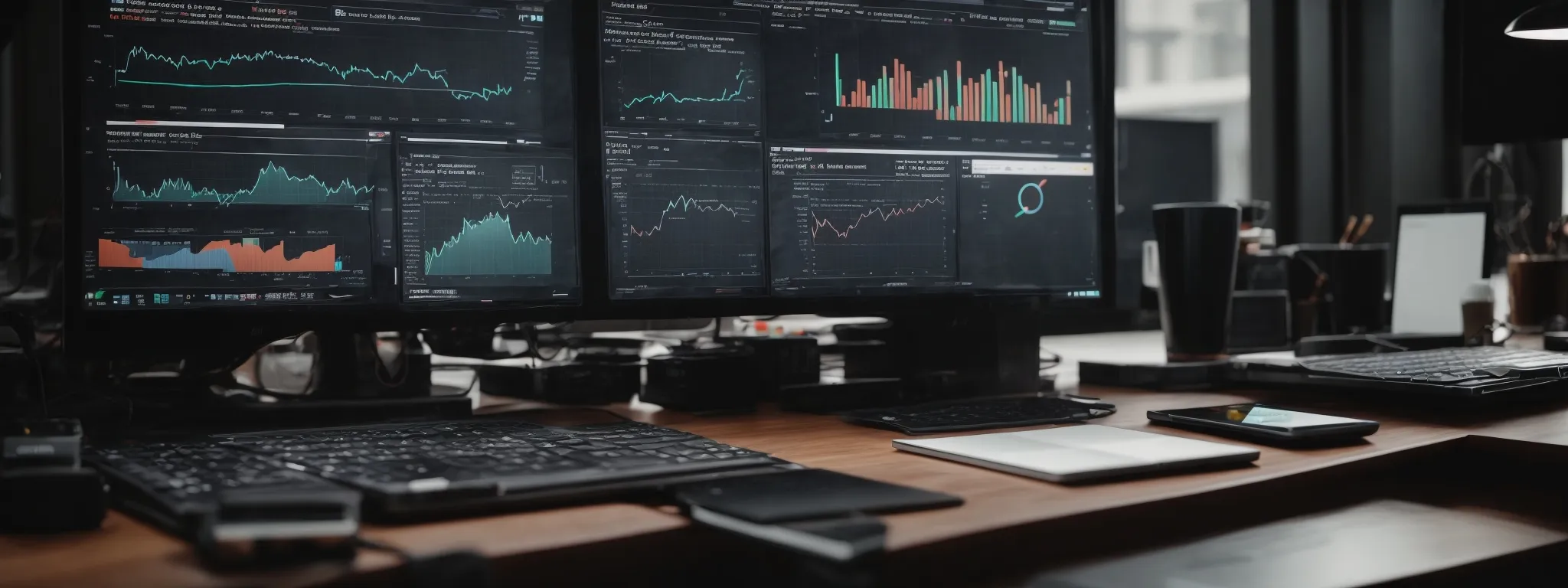Shopify Themes SEO
Maximizing Your Online Store’s Visibility: A Guide to SEO for Shopify Themes In the competitive landscape of ecommerce, standout visibility in search engine results is a cornerstone […]
Maximizing Your Online Store’s Visibility: A Guide to SEO for Shopify Themes
In the competitive landscape of ecommerce, standout visibility in search engine results is a cornerstone of success.
Choosing the optimal Shopify theme that complements robust SEO strategies can elevate a store from obscurity to market dominance.
Owners must not only focus on aesthetic appeal but also ensure their theme enhances site speed, structure, and content delivery – all critical components of search engine optimization.
LinkGraph’s SEO services specialize in transforming Shopify stores into high-ranking, customer-friendly locales.
Keep reading to uncover how selecting the correct Shopify theme can amplify your site’s SEO potential and drive substantial organic traffic.
Key Takeaways
- SEO-friendly Shopify Themes Enhance Store Visibility and User Experience
- Site Speed Is a Crucial SEO Ranking Factor Influenced by Theme Efficiency
- Proper Use of Header Tags and Alt Text Significantly Improve a Site’s SEO
- SEO Apps Can Effectively Extend a Theme’s Optimization Capabilities
- Analytics Apps Provide Essential Insights for Ongoing SEO Strategy Refinement
Selecting the Right SEO-Friendly Shopify Theme

As entrepreneurs and digital strategists scrutinize the bustling Shopify Theme Store for their next storefront design, acknowledging the underpinnings of SEO becomes a cornerstone of their selection process.
In an ecosystem where online visibility equates to customer engagement and eventually sales, the imperative of choosing a theme that not only aesthetically resonates with the brand image but is also finely tuned for search engine success cannot be overstated.
Smart selection involves an in-depth assessment of how themes can enhance or hinder a site’s SEO potential, with a sharp eye on those offering comprehensive SEO features out-of-the-box.
A theme graced with SEO-readiness not only simplifies the climb up the search engine results pages (SERPs) but can significantly streamline the continuous effort required to maintain a Shopify site’s prominence in search queries.
Assessing Theme SEO Capabilities Before Purchase
Prior to investing in a Shopify theme, merchants are advised to meticulously analyze its inherent search engine optimization features. It is imperative for a theme to not only embrace contemporary design elements but to also possess built-in functionalities that bolster a website’s SEO schema.
This investigation extends to the examination of the theme’s ability to offer a Responsive Design, ensuring the site’s compatibility across various devices, and its adaptation to Google’s mobile-first indexing paradigm. A theme ripe with SEO potential should also promise a seamless user experience, influencing both visitor retention and search engine ranking:
- Support for schema markup and rich snippets
- Optimized page load speeds with efficient code
- Integration capability with SEO-focused Shopify apps
- Provision for easy meta tag customization
- Clean and navigable site structure with a coherent sitemap file
Prioritizing Themes With Built-in SEO Features
Delving into the myriad of options available within the Shopify Theme Store can be overwhelming; yet, for store owners who understand the critical nature of SEO, prioritizing themes with built-in SEO features is a strategic move. Such themes come equipped with tools and settings designed to enhance visibility right out of the virtual box, providing a foundation for a stronger online presence.
Themes imbued with comprehensive SEO tools pave the way for a swifter and more efficient optimization process, allowing merchants to focus their efforts on other aspects of their business. Inbuilt SEO capabilities ensure that essential elements such as Mobile Responsiveness, page speed, and user-friendly navigation are in place to align with search engines’ preferences:
- Mobile responsiveness for a uniform user experience across devices
- Accelerated page speeds with clean, efficient coding practices
- User-friendly navigation structures that facilitate ease of access and indexing
Improving Site Structure With Your Shopify Theme

Optimizing a Shopify store’s site structure transcends aesthetic design; it plays a critical role in enhancing user experience and bolstering the site’s SEO framework.
A methodically planned site structure not only simplifies navigation for visitors but also enables search engines to crawl and index content effectively.
At this juncture, the focus shifts to organizing navigation menus and implementing breadcrumbs, each acting as signposts that guide users through the labyrinth of product pages, and blog content, ensuring a fluid and intuitive shopping experience that search engines reward with higher rankings.
Organizing Navigation for Better User Experience
A store’s navigation hierarchy is not just about helping users find products; it’s about communicating to search engines the relative importance of each page and the relationships between them. Properly Structured Navigation Ensures that the maximum SEO value is distilled from each click, navigating both users and search engine crawlers through the site’s offerings with ease and precision.
When visitors encounter an Intuitive Navigation Menu, they are more likely to delve deeper into the site, reducing bounce rates and signaling to search engines that the content is valuable. This alignment between user behavior and search engine algorithms translates into improved SEO performance, directly impacting the visibility and success of the online store.
| Navigation Element | User Benefit | SEO Impact |
|---|---|---|
| Intuitive Main Menu | Effortless product discovery | Clear site hierarchy for crawlers |
| Breadcrumbs | Simplified site traversal | Enhanced content indexing |
| Responsive Design | Uniform experience across devices | Alignment with mobile-first indexing |
Utilizing Breadcrumbs for Easy Navigation
Incorporating breadcrumbs in Shopify themes serves as an effective strategy for demystifying navigation: they are an essential element in guiding both users and search engines through the site’s hierarchy. By displaying a clickable trail for visitors to follow back to the homepage or previous pages, breadcrumbs enhance user experience while reinforcing the site’s structure for improved SEO.
| SEO Attribute | Benefit to User Experience | Impact on Site SEO |
|---|---|---|
| Breadcrumbs | Facilitates navigation and reduces frustration. | Strengthens site structure and aids in content indexing. |
Moreover, breadcrumbs contribute to a reduction in bounce rates by providing users with alternative pathways to explore the site without pressing the back button. This navigational clarity not only augments user satisfaction but also sends positive signals to search engines, ultimately enhancing the store’s SEO performance.
Optimizing Product Pages for Maximum Visibility

Enriching the Shopify experience extends to crafting product pages that not only captivate but also communicate effectively with search engines.
The art of sculpting SEO-rich product descriptions and deploying High-Quality Images with thoughtful alt text is paramount for merchants aiming to secure a powerful online presence.
It’s not merely about informing the prospective customer but also about meticulously embedding the SEO foundations that propel product pages to the summit of search result pages, capturing both attention and traffic.
Writing SEO-rich Product Descriptions
An impeccable product description goes beyond simple features, delving into the benefits that resonate with the target audience, all while peppering in keywords that align with their search queries. With the integration of relevant and high-volume search terms, these descriptions not only inform prospective customers but also serve as a beacon for search engines to anchor the products in a valuable position within the search results.
To secure that coveted spot atop the SERPs, merchants must craft their product narratives with precision, ensuring the language used is both compelling to shoppers and conducive to search engine success. Emphasizing the uniqueness of the product through strategic keyword placement differentiates listings from similar offerings:
- Infusion of primary and long-tail keywords in product titles and descriptions
- Inclusion of persuasive calls-to-action that drive conversions
- Implementation of readability tools for content optimization
Captivating product narratives coupled with strategic keyword optimization act as a dual force, guiding both the consumer’s purchasing decisions and enhancing the website’s visibility. These SEO-rich descriptions play an integral role in transforming browsers into buyers and elevating the site’s prominence within the digital marketplace.
Using High-Quality Images With Alt Text
In the landscape of online retail, the influence of high-quality product images is undeniable: they serve as a storefront window, inviting customers to explore further. Integrating alt text with these images carries dual benefits: it offers descriptive clarity for visually impaired users employing screen readers and provides search engines with context, amplifying the product’s relevance in image searches.
Every image tagged with well-crafted alt text becomes an SEO asset, turning visual elements into searchable components contributing to a product page’s visibility. Alt text should succinctly describe the image while incorporating targeted keywords to maximize its impact:
- Alt text reinforces the product’s presence in image searches, making the visual content indexable.
- Descriptive, keyword-rich alt text aids search engines in understanding and ranking images appropriately.
- Incorporation of alt text ensures accessibility, enhancing the user experience for all visitors.
Boosting Speed for SEO With Shopify Themes

Speed remains a pivotal ranking factor as search engines continually refine their algorithms to prioritize user satisfaction.
An online store’s capacity to operate swiftly is not merely a convenience but a cardinal component dictating its visibility and ranking on search engine results pages.
This crucial aspect of website performance is closely influenced by the theme selected for a Shopify store.
In an effort to optimize speed without compromising on functionality or aesthetic appeal, store owners should prioritize lightweight themes and judiciously manage scripts and plugins.
The ensuing discussion endeavors to shed light on the significance of these elements and their tactical execution in fortifying an online store’s SEO prowess.
Lightweight Theme Selection for Faster Loading
The pursuit of an optimal blend of form and function leads many store owners toward selecting lightweight themes for their Shopify storefronts. By adopting themes that are innately efficient in their coding, merchants ensure that the digital aisles of their online marketplace open swiftly for each visitor, immediately engaging them with a responsive page that contributes positively to the site’s overall SEO standing.
With the paramount importance of site speed in search engine algorithms, a storefront’s swift load time becomes a silent salesperson, enhancing the customer’s experience and signaling to search engines the store’s dedication to performance. For retailers, the strategic selection of a lean, Speed-Optimized Shopify Theme stands as a testament to their commitment to providing a frictionless shopping experience, which is consistently rewarded by higher SERP placements.
Minimizing Scripts and Plugins to Increase Speed
Shopify merchants seeking snappier site performance can achieve significant gains by scrutinizing the use of scripts and plugins. Reducing the number of heavy, non-essential plugins and JavaScript files can lead to improved load times and a streamlined browsing experience, both of which are key indicators used by search engines to evaluate the quality and user-friendliness of a website.
In their quest for speed, store owners must balance functionality with efficiency, selectively employing only the most crucial scripts and plugins that contribute to their operational needs. This disciplined approach to website configuration not only quickens page response times but also fortifies the store’s SEO framework, fostering better visibility in search engine rankings.
Structuring Content for Enhanced SEO Performance

In the dynamic realm of eCommerce, curating an online store that stands out amidst a sea of competitors is paramount.
Leveraging the full spectrum of SEO for Shopify themes involves more than aesthetic choices and technical finesse; it is a strategic interplay of crafting sparkling, keyword-rich blog content and delineating a clear, accessible content hierarchy using header tags.
This artful balance is essential not only in capturing the nuances of consumer interests but also in signaling content relevance and structure to search engines—a critical step in escalating your store’s visibility and driving meaningful traffic.
Implementing Header Tags for Content Hierarchy
Proper Use of Header Tags such as H1, H2, and H3 establishes a clear content hierarchy, critical for both the user and the search engines. Embracing this structure within a Shopify theme facilitates the site’s storytelling, guiding visitors through a logical flow of information while ensuring that search engines can discern the relative significance of various content sections.
Consistently applying header tags across product pages and blog posts can significantly improve a site’s on-page SEO, enabling better content segmentation and keyword distribution. Header tags serve to highlight key content areas, improving indexing and contributing to the site’s overall discoverability in search engine results pages.
Creating Engaging, Keyword-Rich Blog Posts
Blog posts embody an essential aspect of a Shopify store’s content strategy, offering the malleability to weave targeted keywords into engaging narratives. Such posts must captivate readers with relevant and informative content while simultaneously catering to the intricacies of search engine algorithms.
The challenge lies in fostering a balance between substance and SEO: a blend of reader-friendly pieces rich with keywords that seamlessly align with the interests and queries of the target audience:
- Integrating relevant keywords without detracting from the readability;
- Addressing user queries and interests through thorough research and analysis;
- Ensuring content authenticity to build trust and encourage sharing.
By crafting blog posts that serve both as a resource for the consumer and a magnet for search engines, Shopify merchants can elevate their search engine rankings and solidify their online presence.
Leveraging Shopify Apps for SEO Advantage

For savvy merchants committed to elevating their Shopify store’s visibility, integrating SEO apps emerges as a critical strategy.
The strategic use of these applications equips store owners with a seamless extension of their theme’s native capabilities, providing advanced optimization and analytical prowess.
As the digital marketplace teems with competition, the ability to streamline SEO efforts and harness detailed insights through analytics apps is not just an advantage but a necessity.
This orchestration of tools ensures continuous SEO refinement, enabling businesses to adapt swiftly to the changing tides of online search dynamics.
Integrating SEO Apps With Your Shopify Theme
Integrating SEO apps with a Shopify theme is akin to fitting a high-performance engine into a sleek vehicle, propelling the online store to greater visibility and traction in the vast digital marketplace. By selecting apps that complement the theme’s built-in features, store owners can optimize each page’s SEO rankings effectively, ensuring the store’s content resonates with both potential customers and search engine algorithms.
LinkGraph’s SEO services recommend store owners harness the synergy of Shopify’s versatile themes with impactful SEO applications, where each harmonious integration lays a foundation for heightened discoverability. The careful alignment of SEO-focused plugins with the theme’s native amenities ensures a well-oiled e-commerce platform poised for growth and increased search result real estate.
Regularly Monitoring SEO Progress With Analytics Apps
Monitoring the Progress of SEO Initiatives on a Shopify store through analytics apps is a fundamental aspect of any robust digital strategy. These applications provide retailers with the actionable intelligence required to measure the impact of their SEO tactics, allowing them to not only assess performance but also pivot strategies where needed.
With analytics apps, store owners gain a transparent view into metrics such as keyword rankings, organic traffic, and visitor behavior patterns. This level of insight enables a purposeful analysis of SEO outcomes, empowering merchants to optimize their online stores for peak performance in the competitive e-commerce landscape:
| Analytics Metric | Purpose | Impact on SEO |
|---|---|---|
| Keyword Rankings | To gauge visibility in search engine results | Direct reflection of SEO effectiveness |
| Organic Traffic Volume | To measure user attraction without paid ads | Indicator of SEO-driven growth |
| Visitor Behavior Patterns | To understand how users interact with the site | Insights into improving user experience and content relevancy |
Conclusion
In conclusion, maximizing your Shopify store’s visibility hinges critically on selecting and optimizing an SEO-friendly theme.
A theme that supports schema markup, swift page loading, mobile responsiveness, easy meta tag customization, and offers a clean site structure is foundational for climbing the SERPs.
Store owners must embrace themes that provide an intuitive user experience and structured content, with keyword-rich product descriptions and properly tagged images enhancing product visibility.
Speed further plays a pivotal role where lightweight themes and minimized scripts contribute to faster loading times, crucial for SEO.
Additionally, engaging blog content and the strategic use of header tags improve content hierarchy and search engine indexing.
Harnessing powerful SEO and analytics apps can significantly extend a theme’s capability to track progress and finetune strategies, keeping the store agile in a competitive digital landscape.
The integrated approach to SEO in the Shopify theme choice and usage guarantees a robust foundation for heightened online presence and search engine ranking.














































































